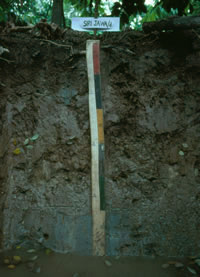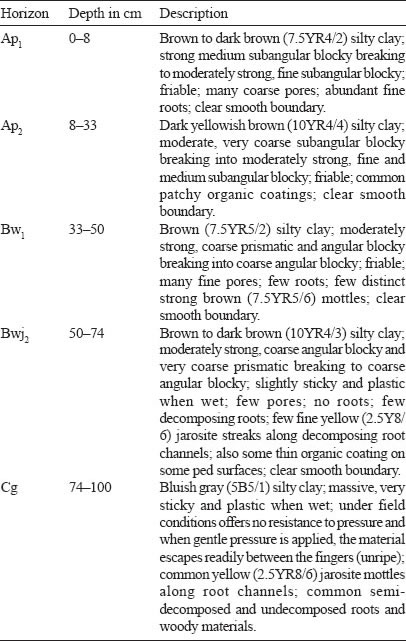Soil Profiles: Jawa
Jawa Series
The Jawa Series is a member of the Jawa Family which is a fine, mixed, isohyperthermic, brown Sulfik Tempajelahs. It typifies this family which is developed over brackish water deposits. These soils have a brown to dark brown silty clay surface horizons which grades into a yellowish brown to brown silty clay B horizons having moderate medium and fine subangular blocky structures and friable consistence. In the lower part of the B horizon below 50 cm depth a sulfuric horizon with jarosite mottles occurs. The bluish gray to grey massive marine clay which is unripe occurs below the sulfuric horizon. In this C horizon jarosite mottles may occur along old root traces.
Type Location
The Jawa Series was first established by Paramananthan (1975) during the survey of Phase I of Johor Barat. Such soils were earlier mapped as Selangor Series shallow phase. The above pedon was described by Noordin Daud (1980) on Sabrang Estate south of Telok Anson, Perak. Location: Topographic Sheet 3460, 4°01’50” N, 100°56’20” E (Grid Reference 3460 – 292463 m).
Range in Characteristics
The Jawa Series may have a surface horizon which is organic but it does not exceed 20 cm and very often the material is sapric. Like many of the other man-made soils, the degree of decomposition depends on the intensity and the length of time the area has been drained. However very often the surface horizon is mineral. The A horizons in the Jawa Series range in colour from black to dark brown, dark grayish brown to dark gray (10YR2/1, 3/3, 4/1, 4/2, 4/3; 7.5YR3/ 2, 4/2, 4/4) and are humic clay, silty clay or clay with moderate to strong medium and fine subangular blocky structures. The B horizons are usually dark brown, brown, dark grayish brown to grayish brown (10YR3/3, 4/2, 4/3, 5/2, 5/3 and 7.5YR4/2) silty clay to clay often rich in organic carbon. Structures in the upper part of the B horizon depending on the drainage ranges from weak coarse angular blocky to strong, medium and fine subangular blocky. Below 50 cm the grade of structure decreases and becomes weak to moderate medium to coarse angular blocky or even prismatic. Consistence is friable in the upper part of the soil but becomes sticky with depth. Mottling is mainly confined to old root channels and ranges from common fine to medium, distinct strong brown (7.5YR5/6–5/8) and few fine distinct reddish yellow (7.5YR6/6–6/8). Below 50 cm depth yellow (2.5Y8/6) jarosite mottles occur mainly along old root traces. The underlying unripe marine deposit is a greenish gray, dark greenish gray or bluish gray (5GY4/1, 5/1, 6/1, 5G4/1, 5/1, 6/1; 5BG4/1, 5/1, 6/1) silty clay to clay which may or may not have jarosite mottles along old root channels. This marine deposit may be encountered either within 100 cm or below 100 cm. Some buried wood is a common feature in this deposit.
Competing Soils and Their Differences
The Jawa Series may be confused with soils of the Sedu, Parit Botak, Tongkang (A), Perepat, Sabrang and Selangor Series. The Sedu and Parit Botak Series have a sulfuric horizon within 50 cm while the Jawa Series between 50 to 100 cm. The Tongkang Series also has a sulfuric horizon between 50 and 100 cm but it has light gray matrix colours, coarser structures and sticky consistence. Both the Perepat and Sabrang Series do not have a sulfuric horizon. The Perepat Series also has light gray colours. The Sabrang Series has almost all features similar to that of the Jawa Series except that a sulfuric horizon is not present in the case of the Sabrang Series. The Jawa Series which have the marine clay below one metre may be confused with that of the Selangor Series because both have friable, brown B horizons. However the Selangor Series either does not have jarosite or if present the sulfuric horizon only occurs below one metre. The underlying marine clay of the Jawa Series is often sulfidic but even if it was not sulfidic the soil is currently placed with the Jawa Series due to the overlying sulfuric horizon. No true acid sulfate soils have been mapped in Sabah and Sarawak to-date as potential acid sulfate soils have only been recently drained. In Sabah, soils of the Bergosong Family (Thionic-Humic Gleysols) when drained may developed into the Jawa Series if the sulfuric horizon occurs between 50–100 cm depth. In Sarawak, soils of the Kluang Series are only potential acid sulfate soils with sulfidic materials between 50–100 cm depth. More data is required to correlate these soils.
Setting
Soils of the Jawa Series form a sequence with soils of the Sedu and Selangor Series. The Sedu Series is characterized by having a sulfuric horizon within 50 cm of the surface while the Jawa between 50 to 100 cm and the Selangor does not have a sulfuric horizon to 100 cm. These soils occur in areas on the coastal plain where they grade into a peat swamp.
Principal Associated Soils
The Jawa Series since it forms a sequence with the Selangor and Sedu Series is often associated with both these soils. These three soils only differ in the depth at which the sulfuric horizon occurs. The Jawa Series may often also be associated with other non-acid sulfate soils such as the Serkat and Sabrang Series. Both these soils only have a cambic horizon overlying the marine clay at different depths.
Drainage and Permeability
The Jawa Series soils are somewhat poorly drained soils. They often have the permanent groundwater table around 50–100 cm. Above this marine clay horizon the B horizon has fairly good permeability.
Use and Vegetation
The Jawa Series is a man-made soil as it is formed by artificial drainage. These soils have been mapped in the past as Selangor Series (shallow phase). These soils are currently cultivated to oil palm, coconut, cocoa, and coffee. Although pineapple, coffee and rubber may have been planted in the past these are slowly being replaced with oil palm.
Distribution and Extent
Most of the areas mapped as Selangor (shallow) have now been reclassified into many soils including the Jawa, Sedu, Serkat and Sabrang Series. It is therefore difficult at this stage to determine the actual extent of these soils. These soils have to-date been identified in the Kerian and Telok Anson areas of Perak, in Selangor, in Malacca, Johor and also in Pahang.
Series Established
The Jawa Series was first established during the semi-detailed soil survey of Johor Barat. The source of the name is the village of Parit Jawa, in Johor.
Remarks on Classification
The Jawa Series is classified here according to the Malaysian Soil Taxonomy – Second Approximation (Paramananthan 1998) as a member of the fine, mixed, isohyperthermic, brown family of SULFIK TEMPAJELAH. These are poorly drained soils which have brown coloured B horizons and a sulfuric horizon between 50 to 100 cm depth. In the Keys to Soil Taxonomy – Eighth Edition (Soil Survey Staff 1998) the Jawa Series would probably be classified as Sulfic Endoaquepts. In the FAO/ UNESCO Soil Map of the World – Revised Legend (FAO 1990) this soil would be classified as Thionic Fluvisols.
Suitability for Agriculture
Crops which only require about 50 cm of soil such as cash crops can be readily cultivated on this soil. Oil palm can also be grown on this soil with good management – especially water control to keep the sulfuric horizon moist. Coconut and coffee should also do well on these soils. Cocoa however is only expected to be marginal on these soils.



